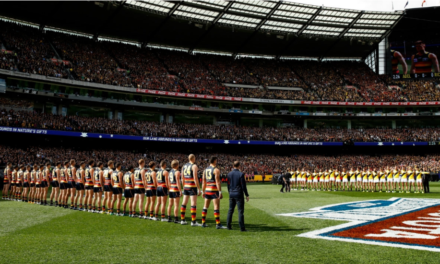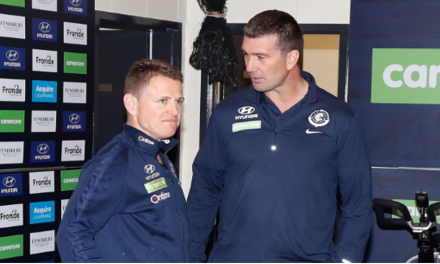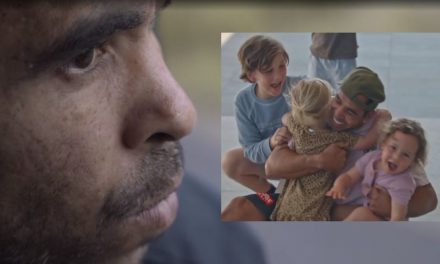Ned Balme with baby daughter, Magnolia, and (inset) Carlton’s Tayla Harris. Photos: NED BALME, MICHAEL WILLSON
I am not part of the “get back in the kitchen” crowd when it comes to women’s football.
As a matter of fact, that particular crowd can do as they so often recommend and go straight to the kitchen to place themselves and their boorish takes right in the bin where they belong.
Admittedly, I haven’t warmed to AFLW like many other footy fans and the 53,000 strong that packed Adelaide Oval at last year’s grand final, but my reasons (like many things in life) have been shaped by situations rather than any nefariously subconscious predispositions.
Throughout my life, I’ve been lucky enough to see women in a position of power in the football world, despite its well-earned reputation as a “boys club”.
My mother, Robyn, maintained high administrative roles in both the SANFL and AFL throughout the 1990s and into the 2000s, so the idea of a strong female figure contributing to our national game wasn’t foreign to me. In fact, it was a regular part of everyday life.
But recently, I’ve been wondering why I hadn’t initially taken to AFLW like I had its male counterpart.
If there was a Venn diagram combining “strong female presence”’ and “Australian football”, I’d be situated smack-bang in the middle, so why hadn’t these two connected with me at the rawest of levels, that being the 120 minutes on the field itself?
Truthfully, there’s something about the marketing and branding of the product that hasn’t sat well with me from day dot.
Admittedly, this is no fault of the players themselves. They’ll lose no sleep over the fact that I haven’t really watched much of the product, and at the end of the day, I’m the one that stands to miss out.
In my albeit brief stint in AFL club land, my employer was in the midst of a bid for one of the inaugural AFLW teams.
Understandably, we in the media department were all very excited about not only having another team in the building, but another team to cover as well. (After all, more content means more value and more value means more job security).
But from where I was sitting, the emphasis on finally providing that long sought-after pathway for elite female athletes seemed secondary to the somewhat vacuous goal of merely “beating our rivals to the punch”.
I understand we tend to romanticise football clubs these days when in actual fact they are a series of multi-million-dollar entities all fighting for marketplace domination, but it was a personal experience that resonated with me for better or worse.
The media also played a part in my initial apprehension, as they walked the precarious tightrope of being equal parts professional broadcasters as well as hype machines for a fledgling league.
I thought there was something disingenuous about referring to players as “superstars” in lieu of any yet proven track record or household name value outside of a select few (see Daisy Pearce, Tayla Harris).
In my opinion, “superstars” have always been chosen by the people. They are players who resonate with spectators in ways that transcend their on-field exploits.
For example, former Eagle Phillip Matera averaged more than 48 goals a season between 1999 and 2005, the same as Eddie Betts over his past seven seasons. A comparable amount of goals, playing the exact same position on the ground, and yet Betts had intangibles that connected with the audience in a way Matera didn’t.
We didn’t need a commentator to tell us Betts’ was a superstar – we decided that for ourselves.
Finally, the lack of civil discord surrounding the game since its inception has been ridiculous.
Admittedly, this is probably more of a social commentary on the world we live in rather than AFLW itself.
But the inability to voice an informed albeit sometimes negative opinion on the state of the game (as is frequently done with AFLM) without subjecting one’s self to backlash is a difficult minefield to navigate at the best of times, and one that is only made harder thanks to the mouth-breathing, sexist comments that litter popular forums.
All this being said, I’ve recently reached a revelation when it comes to AFLW.
And this epiphany all stems from the birth of my daughter, Magnolia Iris Balme, born at 9:28pm on December 4 at Calvary Hospital in Wagga Wagga.
Women’s football in this part of the world is growing at a rate of knots.
The Riverina’s women’s competition has grown from five to seven teams since its inception in 2018, and such is the appetite for the game that even traditional Hume League rivals Lockhart and Osborne actually combined to facilitate a team in the competition’s second season this past year.
While on the big stage, Holbrook’s Alyce Parker is setting a tremendous example for local girls thanks to an appearance in the All Australian 40-woman squad in her debut season for Greater Western Sydney.
Burgeoning local women’s football scene aside – the moment I laid eyes on Magnolia, I quickly realised that if I’m to help foster and nurture any future love she may have for the greatest game in the world, then my disposition against AFLW will have to change, or else what is my problem will quickly become hers.
The outcome of that would be a jaded father whose negative opinion of a particular league (however justified in his own mind) would perpetuate a mistruth that elite female footballers are worth less than their male counterparts.
This is as unacceptable as the inevitable torpedoing of her future dreams that would no doubt occur if this selfish line of thinking continued.
I didn’t have the skill, perseverance, or appetite for physical discomfort that it takes to get to the next level, but I would love nothing more than to see my daughter do what I couldn’t and don the No. 6 for Norwood like her grandfather, Craig, did for 254 SANFL games, or lace up the boots at Punt Road like her great uncle Neil did for all those years.
If she continues the trend of young women finally seizing their opportunity to play Australian football and pursue the game at the highest level, that long, arduous journey can only start with a supportive family and a father willing to join the right side of history.
So here I am – better late than never – ready to appreciate AFLW for all it currently is and all it is poised to be.
Previous gripes be damned, because when it comes to choosing between my daughter and myself, I’ll pick her every time.
I’m on board now. Sorry it took this long.











